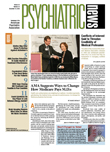The risk of psychosis among first- and second-generation immigrants to the United Kingdom appears to be similar.
That's an important finding because it underscores the well-documented elevated risk for psychosis among immigrants and clarifies that the risk does not diminish depending on how long immigrant groups have been residing in the host country.
The finding was from the East London First-Episode Psychosis Study and was reported in the November Archives of General Psychiatry.
The study also supports the concept that the elevated risk is likely related to environmental factors.
“This suggests that within ethnic groups, the cumulative effect—or load—of factors that serve to increase the risk of psychoses in black and minority ethnic groups is probably similar across generations, although the exact specification of these factors will probably differ,” wrote Jeremy Coid, M.D., and colleagues. “For example, the pressures faced by first-generation black Caribbean immigrants in the 1950s and 1960s were very different from those faced by their second-generation counterparts in the 1990s and beyond. Assuming for a moment that discrimination is a risk factor for psychoses in black and minority ethnic populations, our results support the notion that its cumulative effect is roughly similar across generations, although the form of discrimination has probably changed over generations.”
Coid is with the Forensic Psychiatry Research Unit at St Bartholomew's Hospital, London.
The study was a population-based epidemiological survey during a two-year period among 484 patients with first-episode psychosis in three inner-city boroughs of East London, England. The area is exclusively inner city, characterized by high levels of socioeconomic deprivation; historically, it has hosted a number of diverse ethnic groups who immigrated to the United Kingdom.
All potential cases of psychosis presenting to psychiatric services for the first time (including adult community mental health teams, inpatient units, forensic services, learning disability services, adolescent mental health services, and drug and alcohol units) were screened. Patients were classified as being in one of six ethnic subgroups: white British, white other (predominantly Irish and European groups), black Caribbean (including black other, mixed white, and black Caribbean groups), black African, Asian (Indian, Pakistani, and Bangladeshi groups), and all other ethnic groups (Chinese, other Asian, and other mixed ethnic groups).
Rates in each ethnic group were standardized using the 2001 census population of England and Wales stratified by sex and age.
The researchers found higher incidence rates of both nonaffective and affective psychoses for all of the black and minority ethnic subgroups compared with white British individuals. The risk of nonaffective psychoses for first- and second-generations varied by ethnicity: only black Caribbean second-generation individuals were at significantly greater risk, compared with their first-generation counterparts.
No significant differences between first and second generations were observed in other ethnic groups. Asian women but not men of both generations were at increased risk for psychoses, compared with white British individuals.
The researchers postulated that the greater risk for second-generation black Carribean individuals may be due to the fact that the first-generation cohort in that ethnic group tends to be older than in the other groups and to have bypassed the period of 18-24 years of age, when individuals are at greatest risk of psychosis.
“For other ethnic groups such as the black African and white other groups, where the modal age group in each generation was closer to the main period of risk of psychoses, the elevated risk of psychoses was comparable between first- and second-generation immigrants,” Coid and colleagues wrote.
Ezra Susser, M.D., Dr.P.H., a researcher who has also studied psychosis among immigrant groups and who reviewed the report for Psychiatric News, said it adds to the picture of elevated risk for immigrant ethnic groups that has been reported in a number of studies.
“It's further evidence that something in the socioeconomic environment is causing the increased risk,” Susser said. “And whatever it is has to be common across first- and second-generation immigrants.”
He is a professor of epidemiology at Columbia University's Mailman School of Public Health and a professor of psychiatry at the New York State Psychiatric Institute.
Susser was one of the lead investigators in a study showing that immigrants living in neighborhoods where their own ethnic group represents a very small proportion of the population are at increased risk for psychosis, a finding that points to the influence of social mechanisms—social networks, language fluency, stigma, discrimination and harassment, and other environmental and psychosocial factors—in the etiology of some cases of schizophrenia (Psychiatric News, February 1).
